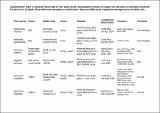Files in this item
Why flower visitation is a poor proxy for pollination : measuring single-visit pollen deposition, with implications for pollination networks and conservation
Item metadata
| dc.contributor.author | King, Caroline | |
| dc.contributor.author | Ballantyne, Gavin Andrew | |
| dc.contributor.author | Willmer, Patricia Gillian | |
| dc.date.accessioned | 2014-08-31T23:01:28Z | |
| dc.date.available | 2014-08-31T23:01:28Z | |
| dc.date.issued | 2013-09 | |
| dc.identifier | 63457716 | |
| dc.identifier | 2a8fcf8a-def5-4018-9c84-cca8af545c23 | |
| dc.identifier | 84883360049 | |
| dc.identifier.citation | King , C , Ballantyne , G A & Willmer , P G 2013 , ' Why flower visitation is a poor proxy for pollination : measuring single-visit pollen deposition, with implications for pollination networks and conservation ' , Methods in Ecology and Evolution , vol. 4 , no. 9 , pp. 811-818 . https://doi.org/10.1111/2041-210X.12074 | en |
| dc.identifier.issn | 2041-210X | |
| dc.identifier.uri | https://hdl.handle.net/10023/5299 | |
| dc.description | Funding: NERC studentship (CK - NE/H527291/1), St Andrews Scholarship (GB) | en |
| dc.description.abstract | Summary The relative importance of specialized and generalized plant-pollinator relationships is contentious, yet analyses usually avoid direct measures of pollinator quality (effectiveness), citing difficulties in collecting such data in the field and so relying on visitation data alone. We demonstrate that single-visit deposition (SVD) of pollen on virgin stigmas is a practical measure of pollinator effectiveness, using 13 temperate and tropical plant species. For each flower the most effective pollinator measured from SVD was as predicted from its pollination syndrome based on traditional advertisement and reward traits. Overall, c. 40% of visitors were not effective pollinators (range 0–78% for different flowers); thus, flower–pollinator relationships are substantially more specialized than visitation alone can reveal. Analyses at species level are crucial, as significant variation in SVD occurred within both higher-level taxonomic groups (genus, family) and within functional groups. Other measures sometimes used to distinguish visitors from pollinators (visit duration, frequency, or feeding behaviour in flowers) did not prove to be suitable proxies. Distinguishing between ‘pollinators’ and ‘visitors’ is therefore crucial, and true ‘pollination networks’ should include SVD to reveal pollinator effectiveness (PE). Generating such networks, now underway, could avoid potential misinterpretations of the conservation values of flower visitors, and of possible extinction threats as modelled in existing networks. | |
| dc.format.extent | 8 | |
| dc.format.extent | 348084 | |
| dc.format.extent | 340460 | |
| dc.language.iso | eng | |
| dc.relation.ispartof | Methods in Ecology and Evolution | en |
| dc.subject | Flower visitor | en |
| dc.subject | Network | en |
| dc.subject | Pollen deposition | en |
| dc.subject | Pollination syndromes | en |
| dc.subject | Pollinator | en |
| dc.subject | Specialization/generalization | en |
| dc.subject | QH301 Biology | en |
| dc.subject.lcc | QH301 | en |
| dc.title | Why flower visitation is a poor proxy for pollination : measuring single-visit pollen deposition, with implications for pollination networks and conservation | en |
| dc.type | Journal article | en |
| dc.contributor.institution | University of St Andrews. School of Biology | en |
| dc.identifier.doi | 10.1111/2041-210X.12074 | |
| dc.description.status | Peer reviewed | en |
| dc.date.embargoedUntil | 2014-09-01 |
This item appears in the following Collection(s)
Items in the St Andrews Research Repository are protected by copyright, with all rights reserved, unless otherwise indicated.


